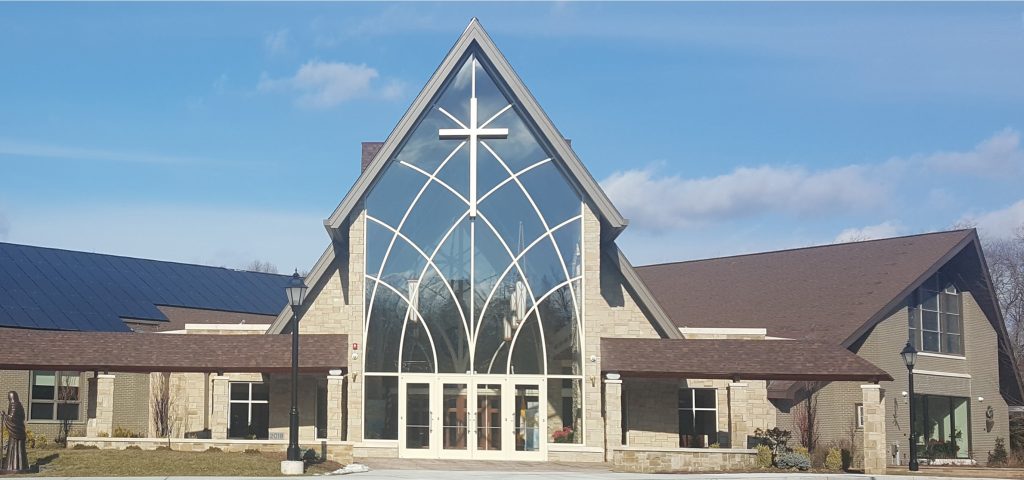The single biggest challenge for live sound in houses of worship (HoWs) centers on acoustics. That said, the issue is also usually a fairly straightforward one: Architecturally speaking, the majority of churches tend toward one variation or another on either the classic cathedral design—rectangular in shape and with high ceilings—or the increasingly popular rooms that are wider than they are long, which are characterized by fan-shaped seating areas. But then there is the Church of the Presentation.
Founded in 1961, this Upper Saddle River NJ congregation has grown from its original 270 families a half-century ago to an estimated 3,500-plus families today. They come from throughout a four-state region, and, according to the church’s website, the group is composed of more than 130 ZIP codes. That means it’s the largest parish in the Archdiocese of Newark. Like many churches, the Church of the Presentation had to figure out strategies to accommodate growth of that magnitude. In this case, the church embraced an ambitious architectural approach, taking its main church building, which had accommodated a separate auditorium and meeting room, in addition to its main seating area in the nave, and turning it into a single worship space. That created a contiguous trapezoidal and modular worship space.
The project, which reportedly cost between $6 million and $7 million to complete, was significant in its scale. It entailed removing the left-side interior wall of the church—the structure’s single longest wall, at 84 feet, which ran from the rear wall behind the main altar to the cry room next to what had been the main entry to the church—and replacing it with an equally long, laminated- wood glulam truss. That opened up what had been an 800-seat auditorium and the narthex—the church’s group-meeting space, located at the middle of the right angle between the auditorium and the existing seating area—into a contiguous space, allowing both areas to face openly on the altar. The altar is at the pivot point of the two largest seating areas, which are now at a 90-degree angle from each other, with the narthex in the middle.
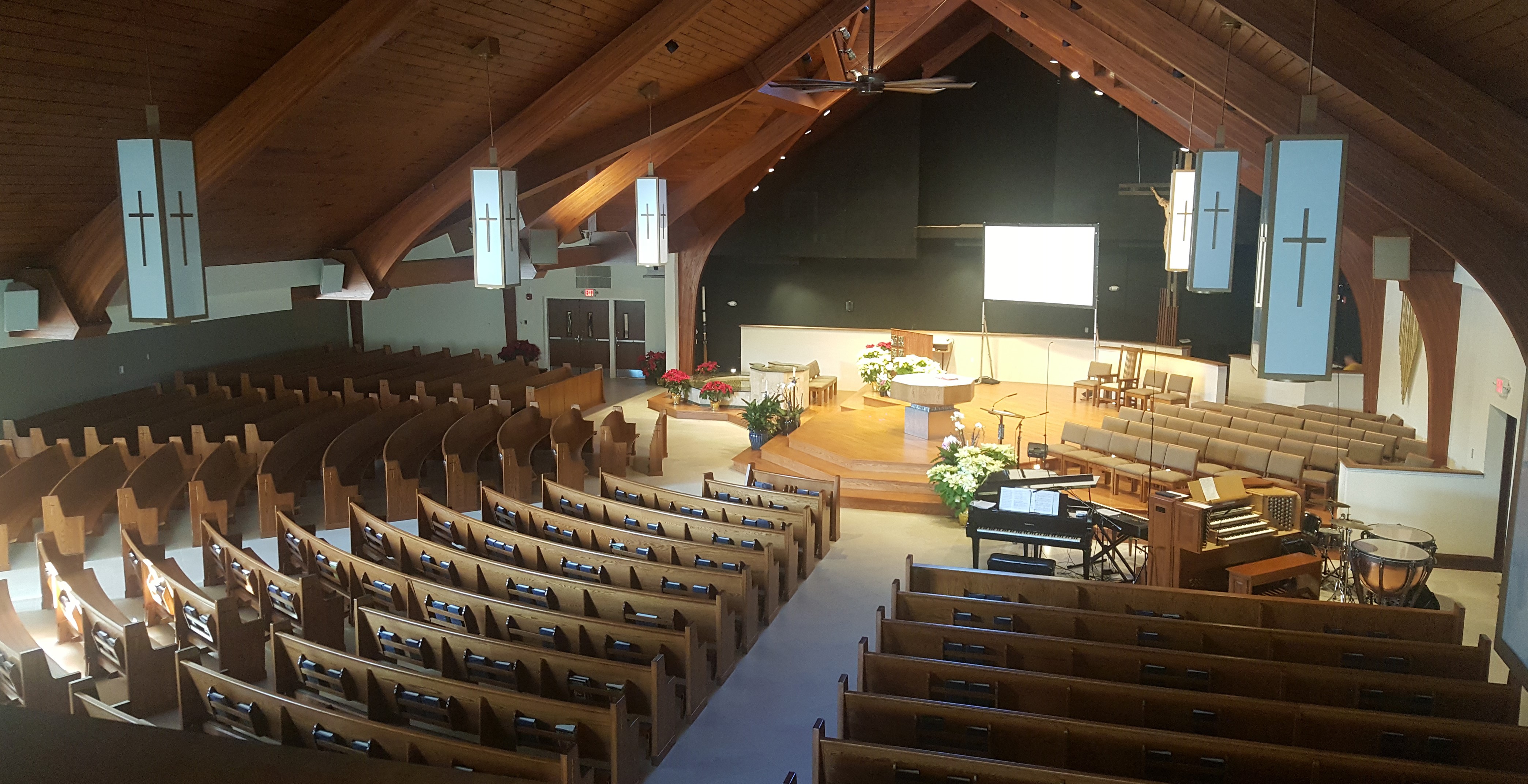
Architecturally and visually, it was a brilliant move, with sightlines clear from the rear of all three areas. The overall seating capacity remains at slightly above 1,200. However, according to Father Bob Stagg, the church’s pastor, uniting all the seating areas has made the church “better, not bigger, and that was our goal—to create ‘one church’ without the need to build a new one.”
Acoustically, however, these major changes created a complex scenario as it relates to speech and music, with sound traveling through a range of spaces of different dimensions, and with varying distances from any particular point source. Complicating matters, the church has a mix of worship styles, ranging from its organ and choir for traditional hymns to provisions for a full band behind and to the right of the altar. A different set of acoustical challenges arose than would have occurred in a conventional cathedral or other large worship space designed= with a single logistical and acoustical profile.
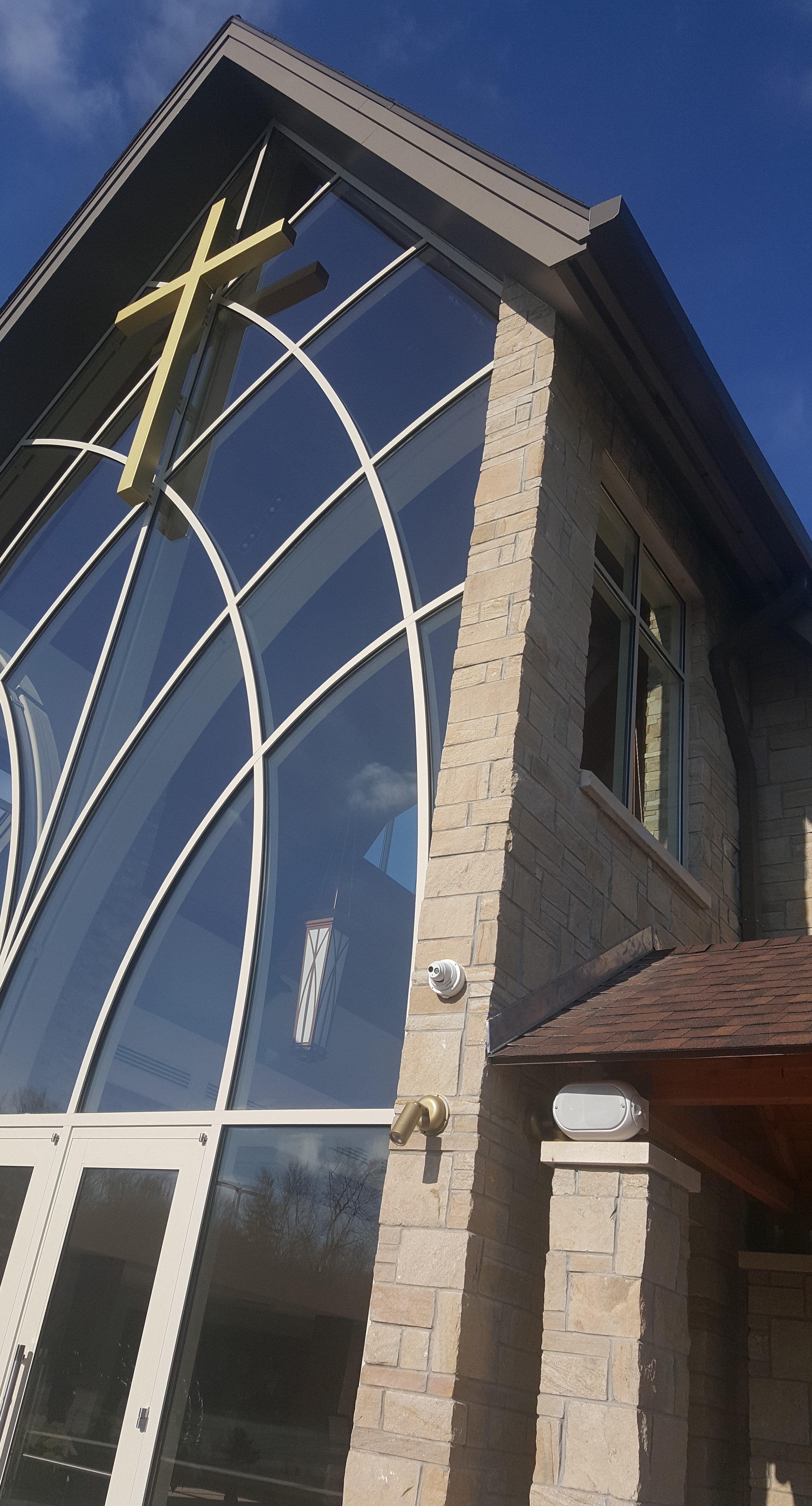
Sound At The Turning Point
The solution was a hybrid point-source/distributed-speaker sound system, according to Steve Minozzi, one of the Co-Owners of Monte Bros., a Westchester NY audio-systems design and integration firm that specializes in sound for HoWs. “The church went from a typical, rectangular design to a big, open space—but one that the sound needed to make a big left turn in,” Minozzi explained. Church of the Presentation selected the right partner, though, given that, 40 years ago, Minozzi was the front-of-house mixer for Cardinal John O’Connor, the late Archbishop of New York. Moreover, Monte Bros.’ business is firmly centered on HoWs and related spaces, such as the Cardinal Dolan boardroom in St. Joseph’s Seminary in Yonkers NY and a new theater for the Diocese of Brooklyn. “We specialize in challenging spaces for sound in houses of worship,” Minozzi affirmed, adding, “but this was the biggest challenge yet.”
With the vertical architectural trusses removed, there was a clear line of sight from the altar to the back walls of all three spaces; however, each one presented a different geometry. The nave was long and relatively narrow, like most cathedrals; the former auditorium was somewhat boxier, but still large; and the newly enlarged narthex was nearly square. For each one, the audio had to arrive at each seat at the same time. A point-source system made the most sense, given the distance of the throws from front to back; however, a series of distributed speakers along the walls of each of the longest spaces would be needed for support, ensuring the full spectrum of sound would make it to each part of each room coherently.
Monte Bros. began work on the system while the church renovation was still in its blueprint stage, using its extensive database of systems designs, compiled during 30 years in business, to estimate the most effective speaker locations. Minozzi said the team decided on the Terra Speakers CAMM Series DT speakers, using four of the larger DT800 speakers flown as point-source transducers (one each to cover the auditorium and the narthex, and two as a left-right pair for the nave). Complementing those are 14 wall-mounted DT400 speakers as the distributed support system along the walls (eight in the auditorium and six in the nave). All of them are mounted using custom brackets locally fabricated to Monte Bros.’ specifications. They are powered by a combination of three Powersoft 1204 QuattroCanali amplifiers and a JBL CSA-140Z amplifier. System control is via a pair of Biamp TesiraFORTÉ AVB AI DSP processors, each connected to its own Biamp Tesira TEC-1S controller.
The main sound system design had been determined and approved, but, first, the integrator had to set up another sound system. This one used the existing system assets of the church, inside the auditorium, across the front of which a temporary sheetrock wall had been put in place; that allowed it to be used as the worship sanctuary for the entire church during the reconstruction process. (Additional weekend services had to be added to accommodate the large congregation in that smaller space.) It was subsequently replaced by a pair of retractable doors that can close off the auditorium as a separate space for events and performances.
“When [the wall is] closed, the church and auditorium operate independently,” Minozzi explained, mentioning that each has its own wall-mounted Tesira TEC-1S controller. “That is one of the logistics that makes this install so unique and also challenging: When the retractable doors are closed, the auditorium is focused in the opposite direction, which requires a completely different speaker time alignment and source speaker for the auditorium.”
The main construction took nearly two years, having started in early 2017. Between the end of the construction and when the church was scheduled to open on December 8 of last year—the Feast of the Immaculate Conception on the Catholic calendar—the integrator found itself with a total of five working days to finalize the locations for all the speakers and then hang them. Wiring—an estimated 15,000 feet of mainly Isotec speaker cable, Belden microphone cable, and Genesis Cat6 wire used for the control panels and Bluetooth audio inputs—was installed by Monte Bros. at predetermined periods during the renovation.
Cabling to a rack in the sacristy behind the altar accommodates the four Audio-Technica ATW-R3210EE1 receivers, and, in the storeroom in the auditorium, the additional four ATW-R3210EE1 wireless receivers and 10 System 10 Pro wireless receivers. But the most critical aspect of the installation was left for last, with just days until when it was intended first to be used.
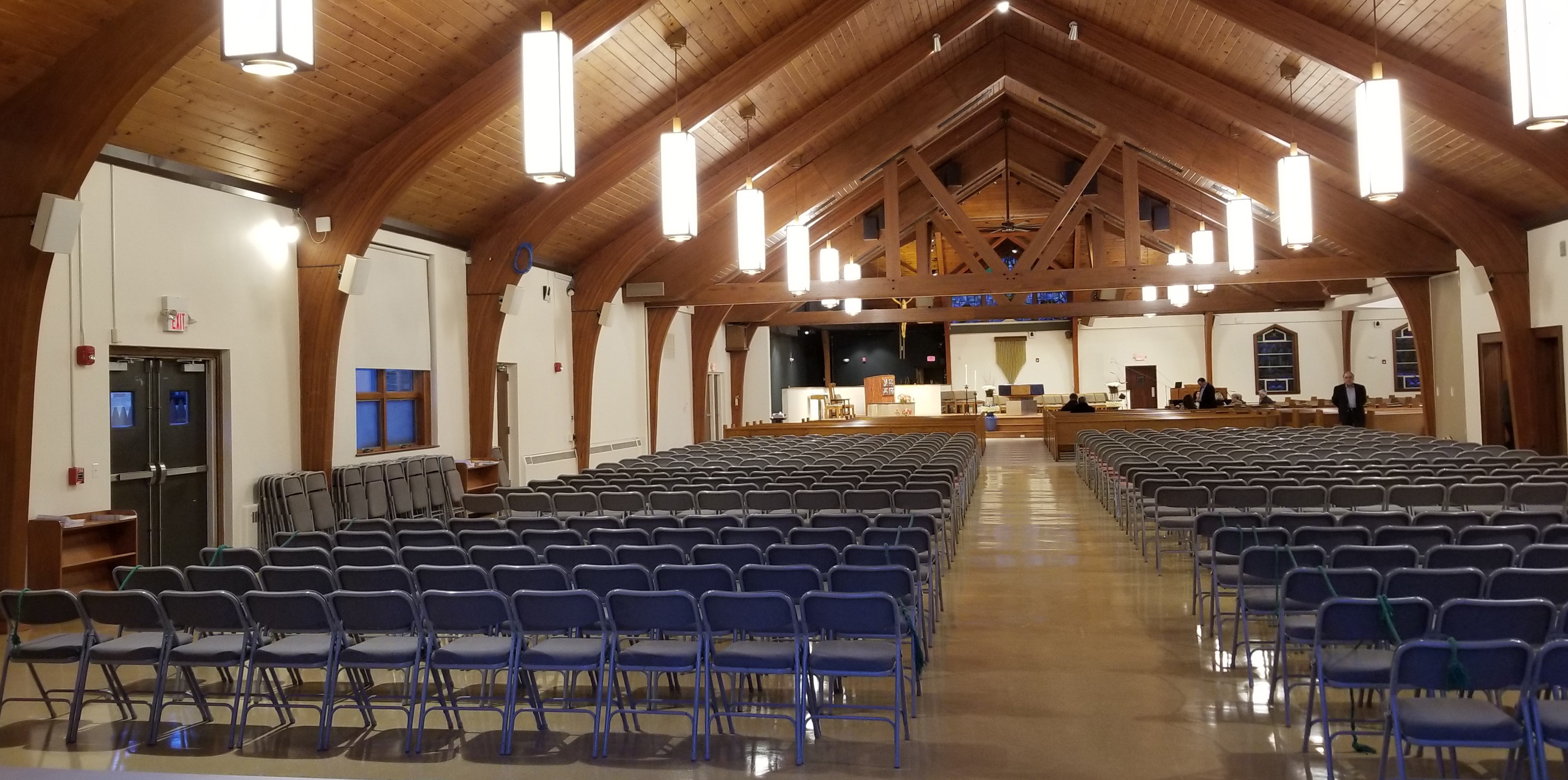
Ready, Aim, Fire It Up
The point-source DT800 speakers were hung from the newly installed truss beam that replaced the old flying-buttress trusses and that now spanned the length of the original church. A laser was used to measure the distances from the point source to the various estimated locations for each distributed DT400 speaker. Those values were input into the Tesira processors, which then determined the exact amount of delay that each distributed support speaker required. That created the correct time-aligned interval, in milliseconds, to allow the sound from the main DT800 speakers to arrive at each location coincident with the sound emanating from each DT400. “The laser measurement is accurate to within a foot,” Minozzi explained. “So, between that measurement and the information we have in our database of about 1,500 installations, we were able to get the speakers placed and firing perfectly.” He continued, “The key was getting the source speakers placed correctly on the new beam and having their yaw [angle of elevation] correctly set, relative to the rooms they are to cover, and to each other in the case of the speakers on the main beam. Once we had that, everything else was just math in the processor.”
The sound is zoned within the processor, but all of that is transparent for the end users, who have individual Tesira controllers to regulate the sound in the two main areas. Each of those controllers has several presets that are preprogrammed by Monte Bros. for various system applications. Those include sound to only one or the other of the main areas, or to both, with a separate on/off setting for the narthex speakers; an on/off setting for the wireless microphones; and individual volume settings for the Audio-Technica AT-899cH wireless lavalier, ESW-T441 handheld and ES961W altar microphones. They also control two Terra Speakers outdoor speakers that are installed on either side of the new main entryway; those can be used as overflow monitors.
No Acoustical Issues
The careful attention to speaker placement also eliminated the need for acoustical treatments anywhere in the church; that’s a surprising fact, given the high number of reflective surfaces inside, and it’s fortunate given the church’s desire to keep the interior aesthetic as clean as possible. “It just wouldn’t have looked good,” Minozzi stated, noting that the padded seats of the folding chairs used in the auditorium provide some serendipitous absorption. “We evaluated the possible use of pew cushions, but the precision of the DSP means we didn’t need it,” he continued. “People have a tendency to put acoustical treatments in churches whether it’s needed or not, because everyone assumes that churches are highly reverberant. They are, but you can deal with that in better ways—using DSP and precise measurements, as we did here. We’ve seen them put padding everywhere, including 60 feet up on the ceiling or under the pews, but it doesn’t accomplish anything. DSP power, when used properly, is awesome.”
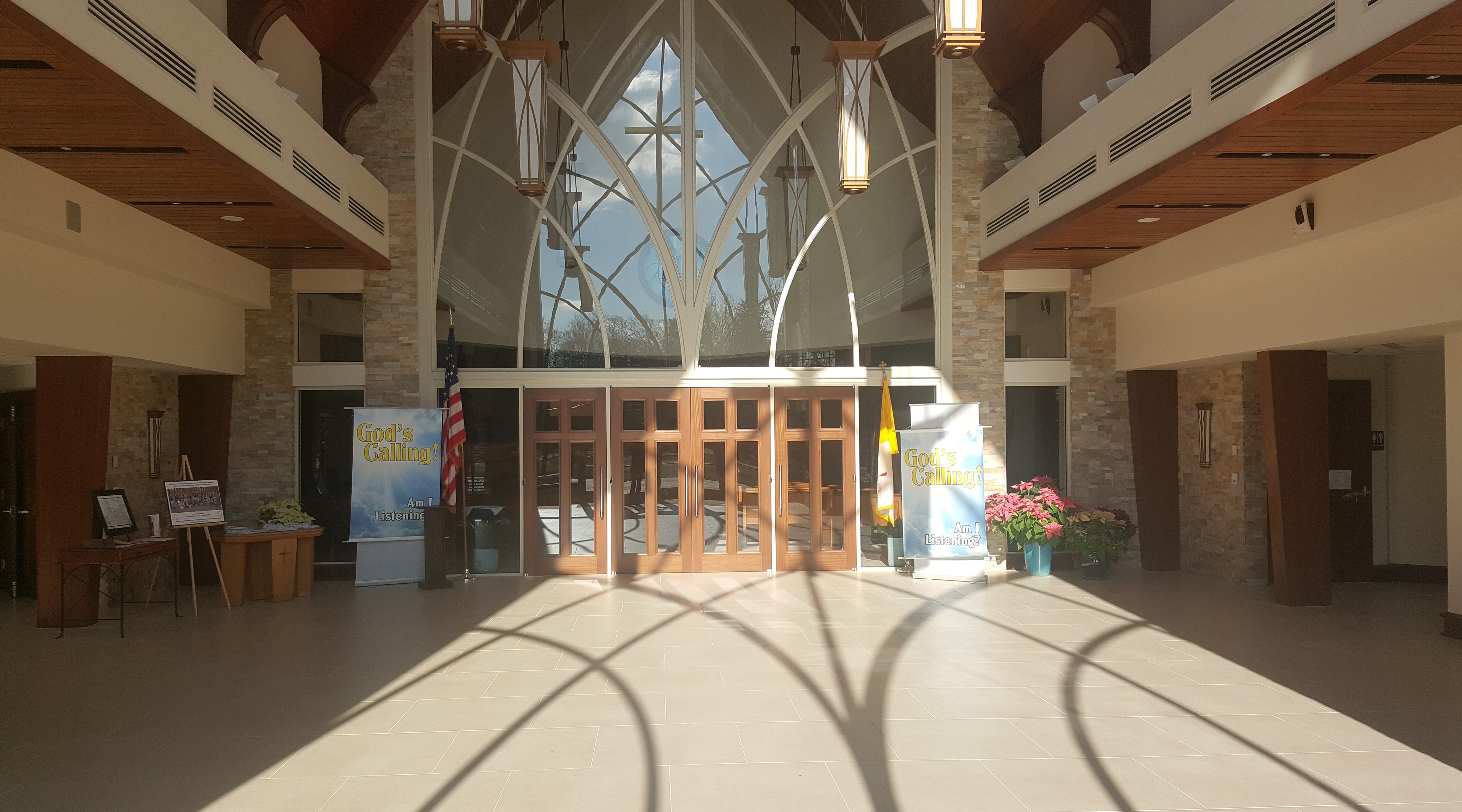
Another application for the DSP has been in managing the sound system’s low end. With no subwoofers in Monte Bros.’ design, the Terra Speakers CAMM Series full-range speakers have to handle the entire frequency spectrum, including the LFE. Minozzi confirmed that’s not a problem because the processing is set to engage audio compression by applying frequency-specific limiting at 100Hz. “We build the file for the music program with that in it,” he explained. “And it doesn’t need to be applied to the speech program.”
The outcome of the entire project was a complete success, Father Stagg affirmed. “It makes maximum use of the infrastructure in place, while creating a worship space that reflects our parish mission, dedication to welcoming others and commitment to future generations.” But he singled out the sound system as perhaps the project’s most notable achievement. “Every pastor has a bug about something, and, for me, it’s sound,” he admitted. “I’d rather have good sound than a good roof. Fortunately, now we have both!”
The topic of live sound in HoWs is well-trod ground, but the singular nature of the Church of the Presentation’s revamped architecture makes this project unique. It also might serve as a template for similar situations; as churches respond to a changing cultural and economic landscape, they’re looking for cost-effective solutions for their physical buildings in times of expansion.
It’s worth remembering that churches were very much at the forefront of putting acoustical considerations on the table for commercial sound-system design in the last 20 years or so. That’s at least one mystery they’ve helped everyone to figure out.
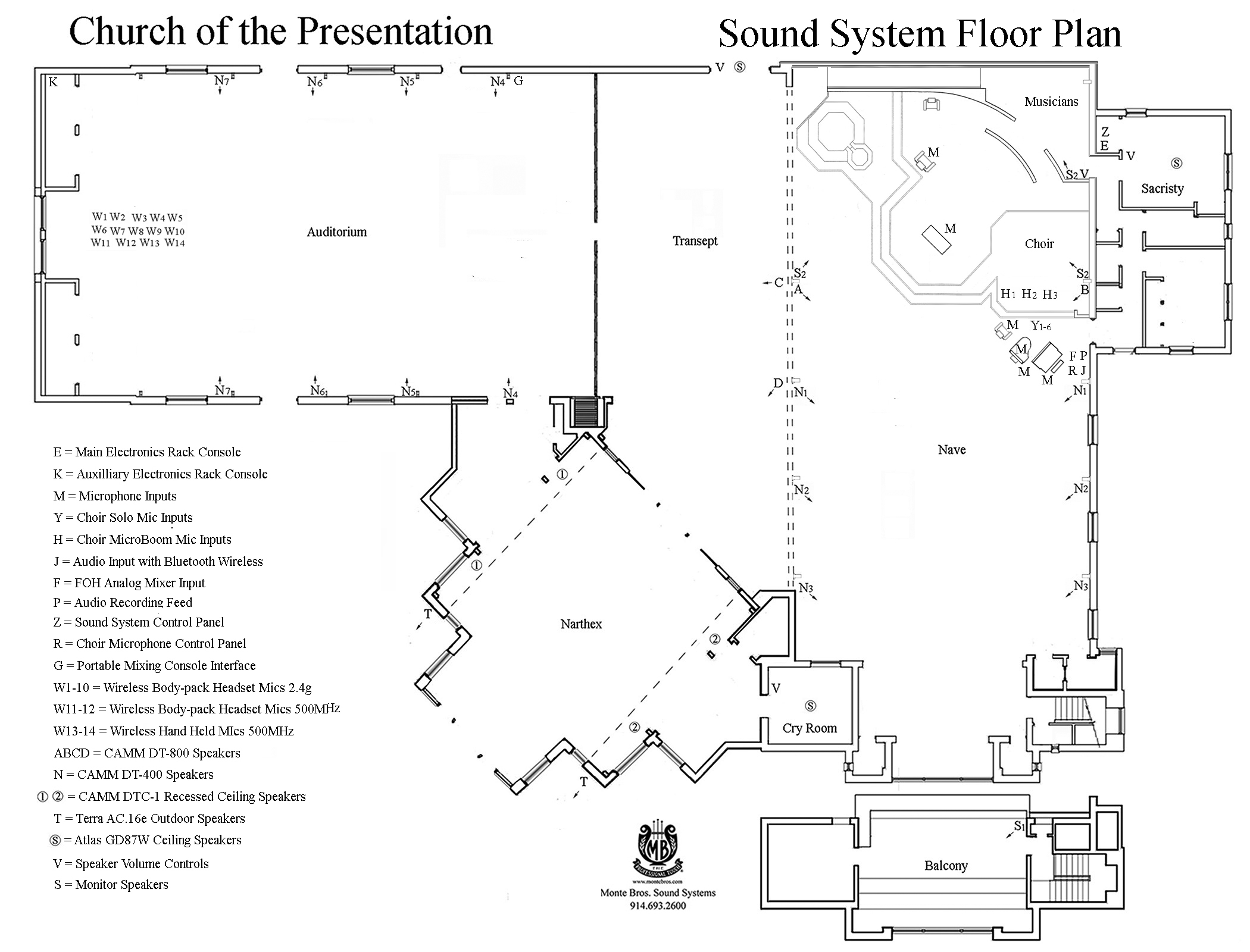 EQUIPMENT
EQUIPMENT
American Data Link multicable
2 Aphex DA-120 distribution amps
1 Applied Microphone Technology AMT M40 piano mic system
2 AtlasIED GD87W 8″ coaxial in-ceiling speakers
2 Audio-Technica AD-SA1230XA power supplies
2 Audio-Technica AT8687 charger link kits
3 Audio-Technica AT899cH subminiature omnidirectional condenser lavalier mics
4 Audio-Technica ATW-CHG3 2-bay smart charging docks
2 Audio-Technica ATW-DA49 UHF antenna distribution systems
6 Audio-Technica ATW-3210EE1 3000 Series (4th-gen) true diversity receivers
5 Audio-Technica System 10 PRO ATW-RC13 rackmount digital wireless receivers
10 Audio-Technica ATW-RU13 System 10 PRO receiver units
10 Audio-Technica ATW-T1001 System 10 digital unipak transmitters
5 Audio-Technica ES915/ML MicroLine condenser adjustable-length gooseneck mics
4 Audio-Technica ES935/ML MicroLine condenser gooseneck mics
3 Audio-Technica ES961W unidirectional condenser boundary mics (white)
6 Audio-Technica ESW UHF wireless receivers (reserve model products modified for Monte Bros.)
5 Audio-Technica ESW-T411 beltpack transmitters (reserve model products modified for Monte Bros.)
2 Audio-Technica ESW-T412D wireless transmitters (reserve model products modified for Monte Bros.)
5 Audio-Technica ESW-T421EE1 wireless bodypack transmitters (reserve model products modified for Monte Bros.)
2 Audio-Technica ESW-T441 handheld wireless mics (reserve model products modified for Monte Bros.)
3 Audio-Technica ESW-T451EE1 wireless handheld transmitters (reserve model products modified for Monte Bros.)
12 Audio-Technica PRO 92cW-TH omnidirectional condenser headworn mics
3 Audix MB1255B miniature condenser mics w/25′ cables and 50″ booms
Belden mic cabling
Belden RG-8/U coax cabling
2 Biamp TesiraFORTÉ AVB AI digital audio servers
2 Biamp Tesira TEC-1s Ethernet control devices
1 Crown Audio XTi 1000 stereo power amp w/DSP
1 Galaxy Audio PA6S portable PA speaker
1 Gator Cases GRC10X12PU popup console rack case
Genesis Cable Cat6 cabling
IsoTek speaker cabling
4 Kaltman Creations IWXCPA2 sets of circular polarized antennas
1 JBL CSA 140Z audio amp
1 Penn Elcom R6612V-1032 12RU wallmount rack cabinet
3 Powersoft Quattrocanali 1204 4x300W amp platforms
14 Terra Speakers CAMM Series DT 400 sound-reinforcement speakers
4 Terra Speakers CAMM Series DT 800 sound-reinforcement speakers
4 Terra Speakers CAMM Series DTC-1 ceiling speakers
1 Ubiquiti Networks secured remote access system
1 Whirlwind custom 20-pair snake fan
1 Whirlwind custom snake cable
1 Whirlwind custom power strip surge protector
List is edited from information supplied by Monte Bros.
